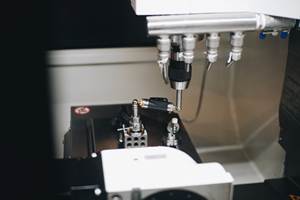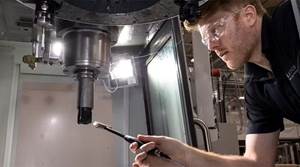Complete Machining of Large Aerospace Parts
Machine Specialties Inc. needed to produce large parts with a constantly increasing degree of complexity. The M120 Millturn from WFL enables the shop to process large components in only one clamping.
Share





Aerospace components can be difficult to machine because of their large sizes, which often keep companies like (MSI) of Whitsett, North Carolina, from being able to process them in a single clamping. This can lead to problems in accuracy and increased machining time. However, with an M120 Millturn from WFL Millturn Technologies Inc. (Wixom, Michigan), MSI has been able to produce large, complex parts in a fraction of the time versus using multiple machines and setups.
MSI focuses on small-batch quantities (ranging from one to 50 parts) for the aerospace, energy and medical industries, as well as parts for high-speed machine tools. CEO Rob Simmons says that, beyond product quality, the company aspires to deliver the highest level of precision. This can be seen in the aircraft landing gear parts it produces in 300M steel for both commercial and military sectors.
In a 150,000-square-foot facility, the company’s 155 employees run 62 CNC machine tools for milling, turning and grinding. In the work-preparation phase, designs and drawings are prepared with a Pro/E CAD/CAM system, and a high number of the necessary CNC programs are created there as well. The company says its strength lies in the seamless process chain from data transfer to finishing the final workpiece.
To reduce throughput times for large parts, in particular, and especially in order to be able to work more efficiently on parts with a high proportion of rotationally symmetric operations, MSI purchased the M120 Millturn complete machining center and put it into operation at the end of 2010.
With its centers distance of 5 meters and turning diameter of 1,100 mm, it is possible to process very large components in only one clamping, says Ben Baggerly, U.S. sales manager at WFL. The Y axis features 650 mm of travel to offer sufficient clearance for comprehensive machining operations in the radial plane, and a 55-kW (74-hp) B-axis milling spindle provides sufficient power reserves for demanding machining operations, he says.
The B axis enables active compensation of long and heavy tools, and can counteract cutting forces with a holding torque of 15,000 Nm. It can be indexed in 2.5-degree increments and held in place with an additional hydraulic clamping using a Hirth coupling. The B axis can be pivoted by a total of +90/−110 degrees and allows inclined boring or milling operations, depending on the tool. The 80-bar (1,180-psi) cutting fluid pressure can be fed directly to the tool via the standard tool attachment.
The automatic toolchanger carousel offers 90 stations to hold a variety of cutters. An additional pick-up station located above the headstock offers space for two boring tools as long as 65 inches. These are held in the WFL prism tool interface via a dovetail guide aligned parallel to the standard tool coupling. The tool is mechanically clamped into this guide and additionally held by the standard coupling.
The M120 Millturn, featuring a Sinumerik 840D CNC, is also equipped with a U axis, which also enables drilling and hollowing operations outside of the center of the rotating workpiece without reclamping. This is especially beneficial for manufacturing aircraft landing gear.
“The possibility of machining complete landing gear parts on the M120 Millturn in a single clamping step has reduced the throughput times at MSI by a factor of 10 in this case,” Mr. Baggerly says. “This avoids machine changes that were previously necessary, which saves on valuable setup time. What used to take several months can now be completed in a few weeks. Only intermediate steps, such as sandblasting or shot peening, still need to be performed separately.”
Related Content
Ballbar Testing Benefits Low-Volume Manufacturing
Thanks to ballbar testing with a Renishaw QC20-W, the Autodesk Technology Centers now have more confidence in their machine tools.
Read MoreHow to Mitigate Chatter to Boost Machining Rates
There are usually better solutions to chatter than just reducing the feed rate. Through vibration analysis, the chatter problem can be solved, enabling much higher metal removal rates, better quality and longer tool life.
Read MoreThe Future of High Feed Milling in Modern Manufacturing
Achieve higher metal removal rates and enhanced predictability with ISCAR’s advanced high-feed milling tools — optimized for today’s competitive global market.
Read More4 Commonly Misapplied CNC Features
Misapplication of these important CNC features will result in wasted time, wasted or duplicated effort and/or wasted material.
Read MoreRead Next
Machine Shop MBA
Making Chips and 91±¬ÁĎÍř are teaming up for a new podcast series called Machine Shop MBA—designed to help manufacturers measure their success against the industry’s best. Through the lens of the 91±¬ÁĎÍř benchmarking program, the series explores the KPIs that set high-performing shops apart, from machine utilization and first-pass yield to employee engagement and revenue per employee.
Read MoreAMRs Are Moving Into Manufacturing: 4 Considerations for Implementation
AMRs can provide a flexible, easy-to-use automation platform so long as manufacturers choose a suitable task and prepare their facilities.
Read More





















